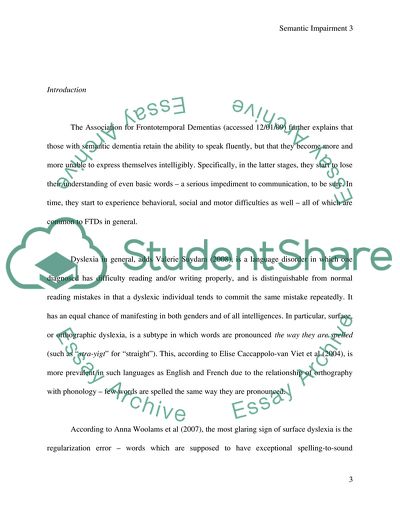Cite this document
(Semantic Impairment with and without Surface Dyslexia Essay Example | Topics and Well Written Essays - 1500 words, n.d.)
Semantic Impairment with and without Surface Dyslexia Essay Example | Topics and Well Written Essays - 1500 words. https://studentshare.org/health-sciences-medicine/1560551-assessing-methodological-and-statistical-issues-in-a-case-study-in-cognitive-neuropsychology-semantic-impairement-with-and-without-surface-dyslexia-implications-for-models-of-reading
Semantic Impairment with and without Surface Dyslexia Essay Example | Topics and Well Written Essays - 1500 words. https://studentshare.org/health-sciences-medicine/1560551-assessing-methodological-and-statistical-issues-in-a-case-study-in-cognitive-neuropsychology-semantic-impairement-with-and-without-surface-dyslexia-implications-for-models-of-reading
(Semantic Impairment With and Without Surface Dyslexia Essay Example | Topics and Well Written Essays - 1500 Words)
Semantic Impairment With and Without Surface Dyslexia Essay Example | Topics and Well Written Essays - 1500 Words. https://studentshare.org/health-sciences-medicine/1560551-assessing-methodological-and-statistical-issues-in-a-case-study-in-cognitive-neuropsychology-semantic-impairement-with-and-without-surface-dyslexia-implications-for-models-of-reading.
Semantic Impairment With and Without Surface Dyslexia Essay Example | Topics and Well Written Essays - 1500 Words. https://studentshare.org/health-sciences-medicine/1560551-assessing-methodological-and-statistical-issues-in-a-case-study-in-cognitive-neuropsychology-semantic-impairement-with-and-without-surface-dyslexia-implications-for-models-of-reading.
“Semantic Impairment With and Without Surface Dyslexia Essay Example | Topics and Well Written Essays - 1500 Words”. https://studentshare.org/health-sciences-medicine/1560551-assessing-methodological-and-statistical-issues-in-a-case-study-in-cognitive-neuropsychology-semantic-impairement-with-and-without-surface-dyslexia-implications-for-models-of-reading.


